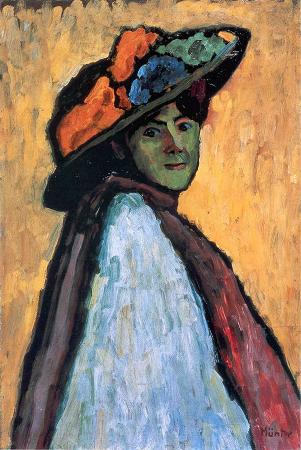Gabriele Munter (1877 - 1962). Gabriele Münter was a German expressionist painter who was at the forefront of the Munich avant-garde in the early 20th century. She studied and lived with the painter Wassily Kandinsky and was a founding member of the expressionist group Der Blaue Reiter. Münter was born to upper middle-class parents in Berlin on 19 February 1877. Her family supported her desires to become an artist. Her father died in 1886. She began to draw as a child. As she was growing up, she had a private tutor. In 1897, at the age of twenty, Münter received artistic training in the Düsseldorf studio of artist Ernst Bosch and later at the Damenschule with artist Willy Spatz. By the time she was 21 years old, both of her parents had died and she was living at home with no occupation. In 1898, she decided to take a trip to America with her sister to visit extended family. They stayed in America for more than two years, mainly in the states of Texas, Arkansas, and Missouri; six sketchbooks survive from Münter's period in America, depicting images of people, plants and landscapes. Both girls had inherited a large amount of money, allowing them to live freely and independently. Her childhood and early adulthood greatly impacted her future artistic career. She had a free and unrestricted life that was unconstrained by convention. Münter studied woodcut techniques, sculpture, painting, and printmaking. In 1901, she attended the beginners' classes of Maximilian Dasio at the Damenakademie of the Münchener Künstlerinnenverein. Münter then studied at the Phalanx School in Munich, an avant-garde institution founded by Russian artist, Wassily Kandinsky. At the Phalanx School, Münter attended sculpture courses taught by Wilhelm Hüsgen. Münter studied outside the official art academies in Munich and Düsseldorf, as these were closed to women. At the Phalanx School, Münter was introduced to Post-Impressionism and the marking techniques of a palette knife and a brush. Her vivid colors and bold outlines were somewhat derived from Gauguin and the Fauves whom she admired. Along with this, Münter was inspired by Bavarian folk art, particularly the technique of reverse-glass painting. Soon after she began taking classes, Münter became professionally involved with Kandinsky. This eventually turned into a personal relationship that lasted for over a decade. Kandinsky was the first teacher that had actually taken Münter's painting abilities seriously. In the summer of 1902, Kandinsky invited Münter to join him at his summer painting classes just south of Munich in the Alps, and she accepted. At first I experienced great difficulty with my brushwork; I mean with what the French call la touche de pinceau. So Kandinsky taught me how to achieve the effects that I wanted with a palette knife. My main difficulty was I could not paint fast enough. My pictures are all moments of life; I mean instantaneous visual experiences, generally noted very rapidly and spontaneously. When I begin to paint, it's like leaping suddenly into deep waters, and I never know beforehand whether I will be able to swim. Well, it was Kandinsky who taught me the technique of swimming. I mean that he has taught me to work fast enough, and with enough self-assurance, to be able to achieve this kind of rapid and spontaneous recording of moments of life. Münter was heavily focused on German Expressionism, and she worked in various mediums, including a significant output in wood- and linocuts. She kept a journal and documented her journeys with a state-of-the-art camera. She was familiar with many of the more famous artists of the time; in one of her journals, she stated that she wanted to learn from the avant-garde artists in France. Münter was part of a small subgroup of artists active in transforming late Impressionist, Neo-Impressionist, and Jugendstil painting into the more radical, non-naturalistic art now identified as Expressionism. Early on, Münter developed a great interest in landscapes. Münter's landscape paintings employ a radical Jugendstil simplicity and suggestive symbolism with softly muted colors, collapsed pictorial space and flattened forms. She enjoyed exploring the world of children; using colorful prints of children and toys, Münter shows precision and simplicity of form in her rejection of symbolic content. By 1908, her work began to change. Strongly influenced by Matisse and Fauvism, Gauguin, and van Gogh, Münter's work became more representative and she took refuge in the small Bavarian market town of Murnau, a village untouched by industrialization, progress, and technology. Münter bought a house in Murnau and spent much of her life there. It was here, in Münter's landscape paintings, that she emphasized nature, imaginative landscapes and an opposition to German modernism. Münter's landscapes are unusual in their use of blues, greens, yellows, and pinks; and color plays a large role in Münter's early works. Color is used to evoke feelings: picturesque, inviting, imaginative, and rich in fantasy. In Münter's landscapes, she presents the village and countryside as manifestations of human life; there is a constant interaction and coexistence with nature.
more...













